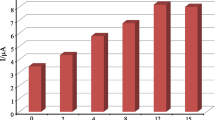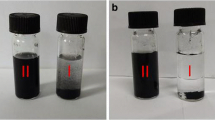Abstract
The electrochemical oxidation of butylated hydroxyanisole (BHA), a synthetic phenolic antioxidant, has been studied by differential pulse voltammetry (DPV) at multiwalled carbon nanotube (MWCNT)-modified platinum sensor in 0.1 M phosphate buffer (pH 4) as supporting electrolyte. The developed sensor showed catalytic activity and stability for BHA oxidation. Linear calibration graph was obtained in the concentration range of 1 × 10−6–1 × 10−7 M, and the detection limit was 9.49 × 10−8 M. Effect of common interfering ions have been investigated in simulated mixtures containing high levels of interfering ions, and the sensor was found to be tolerant against these ions. This method has been proved to be effective and successfully applied for the determination of BHA in commercially available vegetable oil and mayonnaise samples, providing a promising and convenient method to monitor the superscale use of phenolic antioxidant.








Similar content being viewed by others
References
Adams RN (1969) Electrochemistry at solid electrodes. Marcel-Dekker, New York
Agui ML, Reviejo AJ, Yanez-Sedeno P, Pingarron JM (1995) Analytical applications of cylindrical carbon fiber microelectrodes. Simultaneous voltammetric determination of phenolic antioxidants in food. Anal Chem 67:2195–2200
Capitan-Vallvey LF, Valencia MC, Nicolas EA (2004) Solid-phase ultraviolet absorbance spectrophotometric multisensor for the simultaneous determination of butylated hydroxytoluene and co-existing antioxidants. Anal Chim Acta 503:179–186
Ceballos CD, Zón MA, Fernández H (2006) Using square wave voltammetry on ultramicroelectrodes to determine synthetic antioxidants in vegetable oils. J Chem Educ 83:1349–1352
De la Fuente C, Acuna JA, Vazquez MD, Tascon LM, Gomez MI, Sanchez Batanero P (1997) Preparation of a polypyrrole electrode modified with a nickel phthalocyanine complex. Application to the determination of an antioxidant (propylgallate) in foods. Talanta 44:685–695
De la Fuente C, Acuna JA, Vazquez MD, Tascon LM, Batanero PS (1999) Voltammetric determination of the phenolic antioxidants 3-tert-butyl-4-hydroxyanisole and tert-butylhydroquinone at a polypyrrole electrode modified with a nickel phthalocyanine complex. Talanta 49:441–452
Delgado-Zamarreno MM, Gonzalez-Maza I, Sanchez-Perez A, Martinez RC (2007) Analysis of synthetic phenolic antioxidants in edible oils by micellar electrokinetic capillary chromatography. Food Chem 100:1722–1727
Garcia CD, Ortiz PI (1998) Determination of tert-butylhydroxytoluene by flow injection analysis at polymer modified glassy carbon electrodes. Electroanalysis 10:832–835
Gatrell M, Kirk DW (1990) The electrochemical oxidation of aqueous phenol at a glassy carbon electrode. Can J Chem Eng 68:997–1003
Gatrell M, Kirk DW (1993) A study of electrode passivation during aqueous phenol electrolysis. J Electrochem Soc 140:903–911
Guan YQ, Chu QC, Fu L, Wu T, Ye JN (2006) Determination of phenolic antioxidants by micellar electrokinetic capillary chromatography with electrochemical detection. Food Chem 94:157–162
Guo L, Xie MY, Yan AP, Wan YQ, Wu YM (2006) Simultaneous determination of five synthetic antioxidants in edible vegetable oil by GC–MS. Anal Bioanal Chem 386:1881–1887
Issac S, Girish Kumar K (2009) Voltammetric determination of sulfamethoxazole at a multiwalled carbon nanotube modified glassy carbon sensor and its application studies. Drug Test Anal 1:350–354
Laviron E (1974) Surface linear potential sweep voltammetry equation of the peaks for a reversible reaction when interactions between the adsorbed molecules are taken into account. J Electroanal Chem 52:395–402
Litescu S, Radu GL, Diaconu M (2001) antioxidative power evaluation of some phenolic antioxidants—electroanalytical approach. Electroanalysis 13:804–806
Lonappan L, Girish Kumar K (2011) Carbon nanotube based sensor for voltammetric determination of pyridine-2-aldoxime methochloride. Sens Lett 9:541–545
Lonappan L, Issac S, Joseph R, Thomas D, Girish Kumar K (2011) Electrochemical studies of TAM using multiwalled carbon nanotube modified glassy carbon sensor. Micro Nano Lett 6:867–870
Luque M, Rios A, Valcarcel M (1999) A poly(vinyl choloride) graphite composite electrode for flow-injection amperometric determination of antioxidants. Anal Chim Acta 395:217–223
Mc Bridge HD, Evans DH (1973) Rapid voltammetric method for the estimation of tocopherols and antioxidants in oils and fats. Anal Chem 45:446–449
Medeiros RA, Rocha-Filho RC, Fatibello- Filho O (2010) Simultaneous voltammetric determination of phenolic antioxidants in food using a boron-doped diamond electrode. Food Chem 123:886–891
Michalkiewicz S, Mechanik M, Malyszko J (2004) Voltammetric study of some synthetic antioxidants on platinum microelectrodes in acetic acid medium. Electroanalysis 16:588–595
Ni Y, Wang L, Kokot S (2000) Voltammetric determination of butylated hydroxyanisole, butylated hydroxytoluene, propyl gallate and tert-butylhydroquinone by use of chemometric approaches. Anal Chim Acta 412:185–193
Perrin C, Meyer L (2002) Quantification of synthetic phenolic antioxidants in dry foods by reversed-phase HPLC with photodiode array detection. Food Chem 77:93–100
Randles JEB (1948) Cathode ray polarograph. Trans Faraday Soc 44:322–327
Riber J, Fuente C, Vazquez MD, Tascon ML, Batanero PS (2000) Electrochemical study of antioxidants at a polypyrrole electrode modified by a nickel phthalocyanine complex. Application to their HPLC separation and to their FIA system detections. Talanta 52:241–252
Richard Prabakar SJ, Sriman Narayanan S (2006) Surface modification of amine-functionalised graphite for preparation of cobalt hexacyanoferrate (CoHCF)-modified electrode: an amperometric sensor for determination of butylated hydroxyanisole (BHA). Anal Bioanal Chem 386:2107–2115
Rifkin SC, Evans DH (1976) Analytical evaluation of differential pulse voltammetry at stationary electrodes using computer-based instrumentation. Anal Chem 48:2174–2179
Ruiz MA, Garcia-Moreno E, Barbas C, Pingarron JM (1999) Determination of phenolic antioxidants by HPLC with amperometric detection at a nickel phthalocyanine polymer modified electrode. Electroanalysis 11:470–474
Saad B, Sing YY, Nawi MA, Hashim N, Ali ASM, Saleh MI (2007) Determination of synthetic phenolic antioxidants in food items using reversed-phase HPLC. Food Chem 105:389–394
Thomas D, Rajith L, Lonappan L, Issac S, Girish Kumar K (2012) Sensitive determination of nitrite in food samples. Food Anal Methods 5:752–758
Tsang SC, Chen YK, Harris PJE, Green MLH (1994) A simple chemical method of opening and filling carbon nanotubes. Nature 372:159–161
Vikraman AE, Rasheed Z, Rajith L, Lonappan LA, Girish Kumar K (2013) MWCNT-modified gold electrode sensor for the determination of propyl gallate in vegetable oils. Food Anal Methods 6:775–780
Wang J, Jiang M, Lu F (1998) Electrochemical quartz crystal microbalance investigation of surface fouling due to phenol oxidation. J Electroanal Chem 444:127–132
Williams GM (1993) Inhibition of chemical-induced experimental cancer of synthetic phenolic antioxidants. In: Williams GM, Sies H, Baker GT III, Erdmann JW Jr, Henry CJ (eds) Antioxidants: chemical, physiological, nutritional and toxicological aspects. Princeton Scientific Press, Princeton, pp 202–208
Williams GM (1994) Interventive prophylaxis of liver cancer. Eur J Cancer Prev 3:89–99
Xiu LQ, Chao J, Yan-Yan S (2009) Analysis of synthetic antioxidants and preservatives in edible vegetable oil by HPLC/TOF-MS. Food Chem 113:692–700
Yanez-Sedeno P, Pingarron JM, DÌez LMP (1991) Determination of tert-butylhydroxyanisole and tert-butylhydroxytoluene by flow injection with amperometric detection. Anal Chim Acta 252:153–159
Yi H, Wu K, Hu S, Cui D (2001) Talanta 55:1205
Acknowledgments
The authors are grateful to the University Grants Commission (UGC), Council of Scientific and Industrial Research (CSIR), and Defence Research and Development Organisation (DRDO), India, for financial assistance.
Compliance with Ethics Requirements
Krishnapillai Girish Kumar has received research grants from the Defence Research and Development Organisation (DRDO), India.
Conflict of Interest
Zafna Rasheed declares that she has no conflict of interest. Anuja Elevathoor Vikraman declares that she has no conflict of interest. Divya Thomas declares that she has no conflict of interest. Jesny Siri Jagan declares that she has no conflict of interest. This article does not contain any studies with human or animal subjects.
Author information
Authors and Affiliations
Corresponding author
Rights and permissions
About this article
Cite this article
Rasheed, Z., Vikraman, A.E., Thomas, D. et al. Carbon-Nanotube-Based Sensor for the Determination of Butylated Hydroxyanisole in Food Samples. Food Anal. Methods 8, 213–221 (2015). https://doi.org/10.1007/s12161-014-9894-7
Received:
Accepted:
Published:
Issue Date:
DOI: https://doi.org/10.1007/s12161-014-9894-7




